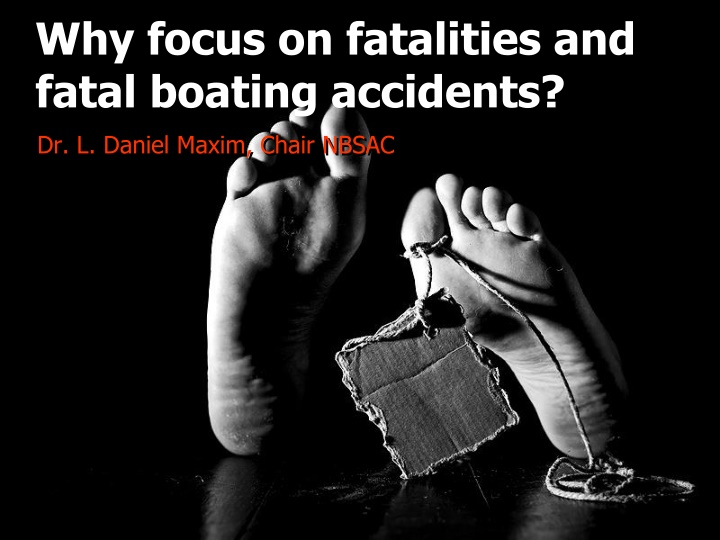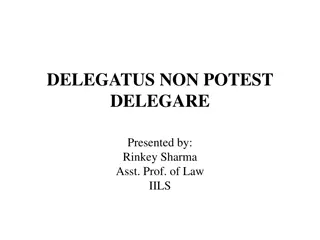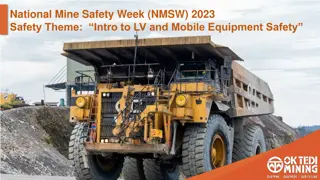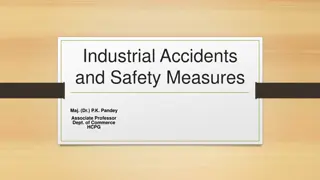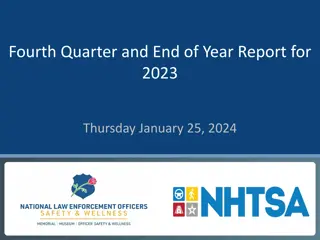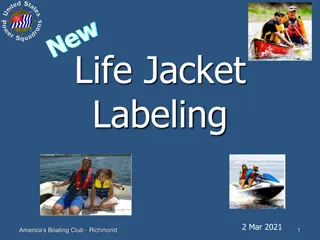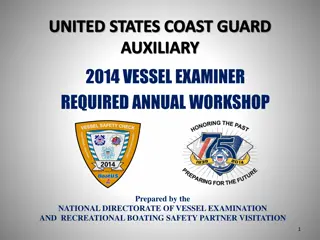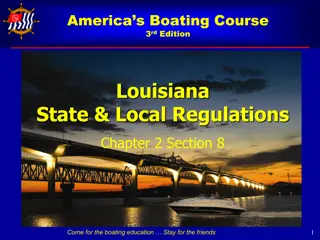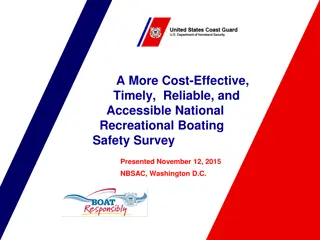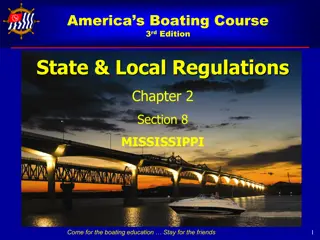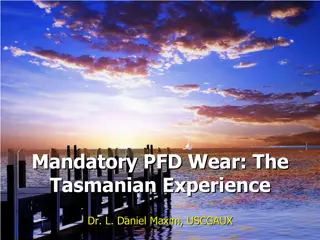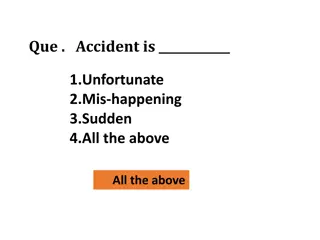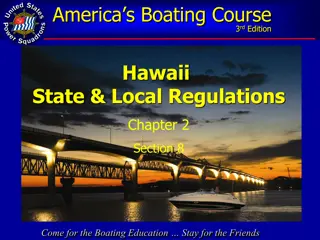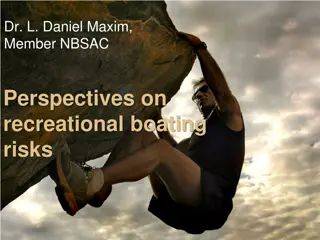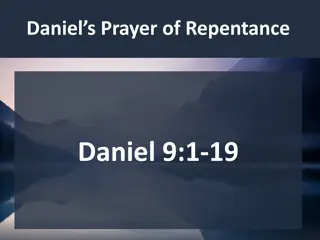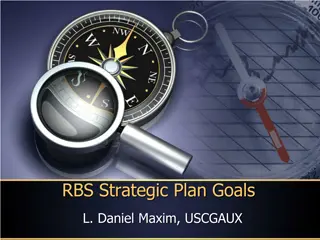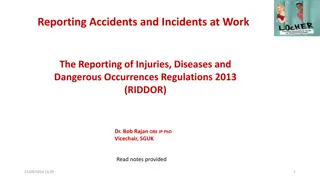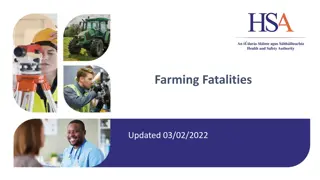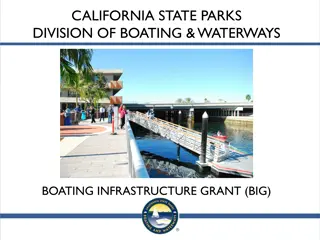Why Focus on Fatalities and Fatal Boating Accidents? Insights by Dr. L. Daniel Maxim
Boating accident statistics often focus on fatal incidents for reasons including knowledge, completeness, social cost, and lessons learned. Nonfatal accidents are under-reported, making fatal data more reliable. Legal requirements mandate reporting of accidents based on specific criteria, ensuring thorough investigation of fatal incidents. Studies consistently support the accuracy of reported nonfatal and property damage only accidents. Recommendations emphasize the importance of researchers concentrating on fatal data due to its high confidence level.
Download Presentation

Please find below an Image/Link to download the presentation.
The content on the website is provided AS IS for your information and personal use only. It may not be sold, licensed, or shared on other websites without obtaining consent from the author.If you encounter any issues during the download, it is possible that the publisher has removed the file from their server.
You are allowed to download the files provided on this website for personal or commercial use, subject to the condition that they are used lawfully. All files are the property of their respective owners.
The content on the website is provided AS IS for your information and personal use only. It may not be sold, licensed, or shared on other websites without obtaining consent from the author.
E N D
Presentation Transcript
Why focus on fatalities and fatal boating accidents? Dr. L. Daniel Maxim, Chair NBSAC
Background Although Boating Statistics attempts to include all reportable accidents, most of the analyses conducted on BARD data for NBSAC have focused on fatal accidents and fatalities One might argue that this omits potentially valuable data and that it is appropriate to consider all accidents (even property damage only [PDO] accidents) 2
Background (contd.) This briefing explains the key reasons for our focus on fatalities. In brief, these include: Knowledge and completeness Potential importance in terms of social cost, and Relevance of lessons learned 3
KNOWLEDGE AND COMPLETENESS 4
Data completeness Although there are legal requirements to file boating accident reports with authorities there is evidence from reliable studies that nonfatal accidents are significantly under-reported (see following) Moreover, it is likely that fatal accidents are likely to be investigated more thoroughly 5
Legal requirement to file an accident report (33 CFR Part 173; Subpart C) The operator of any recreational vessel is required to file a BAR when: 1. A person dies; or 2. A person disappears from the vessel under circumstances that indicate death or injury; or 3. A person is injured and requires medical treatment beyond first aid; or 4. Damage to vessels and other property totals $2,000 or more; or 5. There is a complete loss of any vessel. 6
Studies Over the years the Coast Guard has funded several studies to assess the accuracy of reported accidents with nonfatal outcomes and PDO accidents Results of these studies are consistent 7
Statement in Boating Statistics It is recommended that any researcher focus on fatal data since the confidence of this data is very high. The Coast Guard works with state marine agencies, other federal agencies, and news media aggregating services to identify boating incidents. Despite best efforts to document incidents, the Coast Guard is only confident in its capture of deceased victims since fatal accidents undoubtedly involve state or government oversight, and garner more attention in the news media. 9
Importance The social cost of individual fatal accidents is greater (on average) than for accidents with nonfatal injuries and PDO accidents Even though there are many more nonfatal than fatal accidents, studies suggest that the overall understatement of social costs is probably no more than 25% 11
Importance We should continue to search for ways to increase the completeness of BARD and/or to compensate for under-reporting, but our focus on fatal accidents is certainly justified 12
RELEVANCE OF LESSONS LEARNED 13
Relevance of lessons to be learned There is abundant evidence from studies of other transportation modes that fatal differ from nonfatal accidents in several ways, including: Type of accident, Demographics of participants/victims Accident causes and contributing factors and Counter measures likely to be successful We have limited evidence of the same with boating accidents 14
Top ten contributing factors 2016 boating fatalities 15
Top ten contributing factors 2016 boating accidents 16
Demographic differences automobiles (1990) Per mile driven, men had about 1.5 times the risk of women of experiencing a fatal accident. However, the difference in the fatal rate between men and women was most extreme among the younger age groups, and by age 60, the rates for men and women were essentially identical. For non-fatal accidents, a different picture emerged. Per mile driven, women were found to have a 26% higher injury involvement rate and 16% higher rate in all police-reported accidents compared to men. 17
Lessons to be learned: industrial accidents In September 1998 Esso Australia s gas plant at Longford in Victoria, Australia, suffered a major fire. Two men were killed and the state s gas supply was severed for two weeks, causing chaos in Victorian industry and considerable hardship in homes which were dependent on gas. A warm liquid system (known as the lean oil system) failed, allowing a metal heat exchanger to become intensely cold and therefore brittle. When operators tried to reintroduce warm lean oil, the vessel fractured and released a large quantity of gas which found an ignition source and exploded.18
More on Longford There is often an attempt to blame major accidents on operator error. This was the position taken by Esso at the Royal Commission. Esso argued that operators and their supervisors on duty at the time should have known that the attempt to reintroduce a warm liquid could result in brittle fracture. Later analysis showed that a major contributing factor was the fact that Esso had not carried out a critical hazard identification process, standard in the industry, know as a HAZOP (short for hazard and operability study. 19
More on Longford Ironically Esso s safety performance at the time, as measured by its Lost Time Injury Frequency Rate, was enviable, indeed award winning To understand this paradox of how a company with such an enviable safety record was apparently so inattentive to the hazards which led to the fire we need to distinguish between high frequency low severity events such as slips, trips and falls, which result in injury to single individuals and low frequency high severity incidents such as explosions and major fires, which may result in multiple fatalities 20
Conclusion It may be appropriate to study all types of accidents to identify causes, contributing factors, and possible counter-measures But a focus on fatal accidents is certainly justified in terms of data completeness, probable accuracy, relevance, and social cost 21
Conclusion In short, focus on fatal accidents is justified because: The accident database is virtually complete The accidents are well investigated typically by trained investigators rather than reported by participants The accidents are more representative of high value accidents in terms of causes, contributing factors, accident types, and clues for intervention strategies 22
